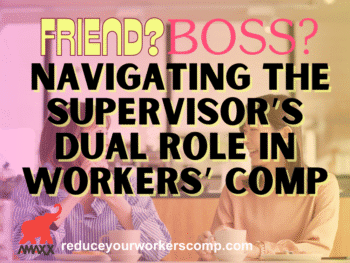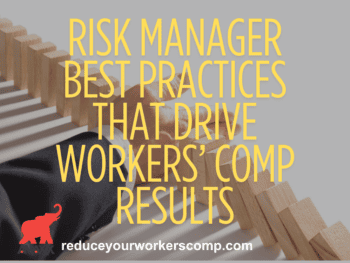Workers’ compensation is often viewed simply as a cost of doing business. Unfortunately, this mistake in philosophy as well as other common challenges cost the employer money and negatively impact the claim outcome for the injured worker.
Here are the top 9 mistakes that employers make when it comes to controlling the cost of their workers’ compensation insurance.
-
Lack of a Strong Safety Program
The failure to provide the employees with a safe work environment. Employers who:
- utilize safety training,
- have completed a job hazard analysis for every job position within the company,
- complete work-site evaluations and inspections, and
- have a safety specialist and/or a safety committee
…will have significantly fewer on-the-job injuries, resulting in lower workers’ compensation costs.
Click Link to Access Free PDF Download
-
Lack of Return to Work Program.
The lack of an established Return to Work Program is the probably the second most expensive mistake an employer can make. The longer the employee is allowed to remain off work and drawing indemnity benefits, the higher the cost of the claim and the higher the resulting workers’ compensation premiums will be.
By returning the employee to modified duty or light duty work until the employee is able to resume his regular duties, the employer receives the benefit of some production from the employee. Also, light duty work will speed the employee’s recovery and lower the extent of any permanent disability rating, resulting in a lower disability award.
-
Alienation of the Employee
The alienation of the employee after an injury is a major mistake made by employers. Way too many employers simply forget about the employee once they have reported the injury to the claims office. Everyone has a certain amount of need for reassurance of their value to the company.
If the employee never hears from the employer after the accident, they tend to think the worst. Employees who have regular contact with the employer after an accident seldom become adversarial and hire an attorney. By keeping the lines of communication open with the employee after an accident, the employee recognizes the employer is concerned about their well being.
-
Failure to Timely Report a Workers’ Compensation Injury
A mistake an employer should never make, but occurs too frequently, is the failure to timely report a workers’ compensation injury to the claims office. An employer who saves up all their work comp claims for the week to report to the claims office each Friday is being penny wise with their time and pound foolish with their money.
Every department supervisor within your company should know that as soon as they have arranged transportation of the injured employee to a medical facility, the next step before they do anything else is to report the claims to the company’s workers’ compensation claims coordinator or to report the claim directly to the claims office. The sooner the claim is reported, the faster the adjuster can start the claim investigation, and provide the required benefits to the employee, if appropriate.
-
Hands Off Approach to Your Workers’ Compensation Claims
A hands-off approach to your workers’ compensation claims will result in higher insurance cost. The employer should make the employee’s supervisor available to the adjuster to discuss the details of the accident and assist the adjuster with the investigation in any way needed. The smart employer will not only stay in contact with the employee after an injury, the smart employer will also stay in contact with the work comp adjuster.
The employer should convey to the adjuster all information about the work comp claim that is given to them by the employee. While some of the information will be a duplication of what the adjuster may have already obtained, there will be information that will assist in the processing of the claim.
-
Failure to Manage & Control What Happens Before & After a Claim
The failure to manage and control what happens before and after a claim happens is a mistake many employers make. All supervisors should be trained on what to do when a claim happens. All employees should be provided a brochure, both when they are hired and annually, with a written guide on what the employee should do when an accident occurs. The injury procedure policy should be posted where all employees can see it. All state required notices, OSHA notices, required (or suggested) medical providers and fraud prevention posters should be posted.
-
Not Controlling the Medical Provider Selection
A costly mistake some employers make is not controlling the selection of the medical provider in the states where the employer can do so. If the state allows the employer to select the medical provider, the approved medical facilities should be posted where every employee will know who they are in the case of an accident. In the states where the employee is allowed to select the medical provider, the employer should post a list of suggested medical providers.
More often then not, in a non-emergency situation, the employee will select from the suggested list of medical providers, especially if the employer has managed and controlled the work comp claim process (see # 6 above).
FREE DOWNLOAD: “5 Critical Metrics To Measure Workers’ Comp Success”
-
Failure to Fight Workers’ Comp Fraud
According to the National Insurance Crime Bureau, up to 25% of all workers’ compensation claims have some element of fraud. The failure to fight fraud can be a costly mistake for the employer. Every employer should have a fraud prevention program and know the red flags (indicators) of potential employee fraud. All employers should make it clear that workers’ compensation fraud is a crime and will be fully prosecuted. Plus all employees should know that work comp fraud takes money away from their raises and/or bonuses.
-
Incomplete Medical Management Program
An incomplete medical management program will definitely add to the cost of workers’ compensation. Every employer should make sure their workers’ compensation insurer or self-insured program uses all the medical cost reduction techniques available including medical fee schedules, bill reviews, nurse case, utilization review, pharmacy benefit managers and medical provider management networks. By utilizing all available medical cost management techniques, the overall cost of workers’ compensation can be lowered.

Author Michael Stack, CEO Amaxx LLC. He is an expert in workers’ compensation cost containment systems and helps employers reduce their workers’ comp costs by 20% to 50%. He works as a consultant to large and mid-market clients, is a co-author of Your Ultimate Guide To Mastering Workers Comp Costs, a comprehensive step-by-step manual of cost containment strategies based on hands-on field experience, and is founder & lead trainer of Amaxx Workers’ Comp Training Center .
Contact: mstack@reduceyourworkerscomp.com.
Workers’ Comp Roundup Blog: https://blog.reduceyourworkerscomp.com/
©2018 Amaxx LLC. All rights reserved under International Copyright Law.
Do not use this information without independent verification. All state laws vary. You should consult with your insurance broker, attorney, or qualified professional.
FREE DOWNLOAD: “5 Critical Metrics To Measure Workers’ Comp Success”
















